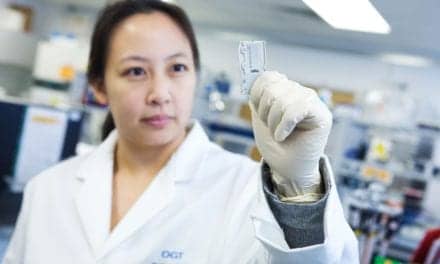Molecular biologists in clinical laboratories are faced with the challenges of nucleic acid testing every day. One of the more demanding areas is the extraction of nucleic acid from biological samples. Indeed, sample preparation is considered by many to be the most painstaking area of molecular-based testing, with laboratories indicating they expend a significant amount of their labor resources in this area. As the typical starting point for molecular diagnostics, it is where efficient extraction of nucleic acid and removal of potential downstream reaction inhibitors often impact the end result. The starting materials themselves can be fairly demanding when various volumes and/or types of samples are depending upon the test requirements. Infectious-disease applications are particularly critical, since there may be relatively little target nucleic acid for recovery and concentration in the final eluate.

|
There is a wide variety of manual and automated methods for extracting nucleic acid in the clinical laboratory. Manual methods have certainly come a long way over time, with various commercial offerings that include complete kits containing most of the components needed to isolate nucleic acid. However, most manual methods are still fairly labor-intensive and limited in terms of overall throughput. Automated systems designed for medium to large laboratories have grown in presence over recent years, and while they have certainly improved upon throughput, they generally have disadvantages surrounding complexities of the robotics, overall lack of flexibility, and the fact that some require a large amount of disposable materials.
The NucliSens® easyMAG™, developed by bioMérieux, is an automated system specifically optimized for extracting high-quality RNA and DNA in a user-friendly manner. The focus of the development was twofold: to maximize the performance of the underlying nucleic acid-extraction chemistry; and to enhance the overall design, accessibility, and convenience of an automated platform, particularly when compared to earlier-generation instruments.
High-Quality Nucleic Acid-Extraction Chemistry
The foundation of any automated nucleic acid-extraction system is the extraction chemistry itself. BOOM® technology, bioMérieux’s proprietary process, is a gold standard for the universal extraction of RNA and DNA without the use of organic solvents. It is based upon the lysing and nuclease-inactivating properties of the chaotropic salt guanidinium thiocyanate, combined with the nucleic acid-binding qualities of silica.
The easyMAG automates a magnetic silica variation of BOOM chemistry. The paramagnetic particles, combined with optimization of the extraction buffers, result in performance enhancements to this already proven chemistry. Using a single set of reagents and one generic protocol, laboratories are able to extract total nucleic acid in front of various downstream molecular applications.
The Molecular Diagnostics Laboratory in the Microbiology Department at Albany Medical Center (Albany, NY) uses the NucliSens easyMAG for viral RNA extraction in front of HIV and HCV viral load testing. It is also in the process of validating it for several DNA targets that include CMV, VZV, JC, and BK viruses; Bordetella pertussis; Legionella; Mycoplasma pneumonia; M. hominis; M. genitalium; and Ureaplasma. Before evaluating the easyMAG, the lab was using the NucliSens® miniMAG™, a manual magnetic nucleic acid-extraction system for RNA targets, and phenol-chloroform for DNA targets.
“We performed a comparative analysis to assess analytical sensitivities of the various extractors on the market before selecting easyMAG,” says Kathleen Stellrecht, PhD, D (ABMM), and director of microbiology at Albany Medical Center. “We compared easyMAG against two other extractors, and all three extraction systems recovered two TCID50/µl of Enterovirus RNA. However, the easyMAG consistently recovered RNA from this concentration of virus. The other two extractors did not demonstrate such consistency.
“The recovery of DNA by the three systems was more interesting. The NucliSens magnetic-extraction reagents demonstrated the greatest sensitivity for the isolation of HSV. This system was able to recover as little as 0.03 copies/µL of HSV-1, while the other two systems were able to detect only 0.54 copies/µL of HSV-1. It is also important to note that our studies demonstrate that the NucliSens magnetic-extraction reagents are much more efficient at removing inhibitory substances,” Strellrecht says.
Achieving Flexibility in Automated Nucleic Acid Extraction
As the demand for molecular testing grows, more decentralization of the testing will occur, and the menu of tests that laboratories need to offer will continue to expand. This requires automated extraction platforms to become more flexible to accommodate the specific parameters of different molecular assays. In the nucleic acid-extraction process, this flexibility applies to the starting sample input as well as the final output or elution volumes. The NucliSens easyMAG supports the processing of variable sample input volumes (as low as 10 µL, up to 1,000 µL for plasma) as well as different samples within the same run. The user is also able to select different elution volumes for adjacent samples within the same sample run, with the ability to choose an elution volume as low as 25 µL for more sensitive applications.
“I like the fact that I can have the exquisite sensitivity that the NucliSens chemistry provides in an automated format,” Stellrecht says. “We use three different extractors in our lab to accommodate various testing methods, and the easyMAG is our workhorse. The easyMAG has the potential to help our laboratory’s productivity tremendously. The full impact will be realized once we transition all our tests to this platform.”
Design Simplicity Means Higher Productivity
A primary goal in developing the NucliSens easyMAG was to minimize complexities often seen in traditional designs of instrumentation supporting nucleic acid extraction. One principal design concept was “single-plane mechanics,” where each basic function is performed with an instrument component that moves in a single, fixed plane. These functions include dispensing of extraction buffers, aspiration/removal of buffer waste, and the operation of magnet arrays.
What emanated from this design was a simplified process centered on a stationary sample where the entire isolation and purification process is performed in a single well. The easyMAG sample well, or compartment, is uniquely shaped to accommodate each step of BOOM extraction: sample lysis, plus the binding, washing, and elution of nucleic acid. There is no need for multiple processing of blocks and plates. During a sample run, the instrument’s aspiration manifold is fitted with aspiration tip sets, the result being one aspiration tip per sample. Each aspiration tip remains in fixed alignment with its respective sample; thus, it eliminates any need for multiple racks of disposable tips, and greatly reduces the risk of sample-to-sample cross contamination.
The easyMAG instrument also features onboard reagents where bottles of buffers are continuously monitored for the remaining volumes by the system. Each bottle of buffer is stable for multiple runs, and the user is notified when a new bottle of any individual buffer is necessary. Therefore, reagent handling is greatly simplified. Given the undemanding operation of the easyMAG, a full run of 24 primary samples can be completed in approximately 1 hour, including hands-on time.
The virology manager at Yale-New Haven Hospital Medical Center (New Haven, Conn), David Ferguson, explains why they are evaluating the easyMAG for the clinical virology laboratory. “We have used the NucliSens miniMAG for almost 2 years and have been impressed with its performance and the high-quality recovery of DNA and RNA,” Ferguson says. “Our lab is seeing a higher volume of tests, and we decided to evaluate the easyMAG to accommodate a heavier workflow. Halfway into the evaluation period, we can see the easyMAG would greatly increase productivity. Our technologists also like the single-plane movements of the easyMAG, because it offers an extra level of protection. This is critical, because cross contamination would be disastrous.”
Over time, nucleic acid-extraction processes have become more standardized, and automation has further simplified what was once an extremely labor-intensive and time-consuming task. For molecular-diagnostic laboratories that are struggling with ways to improve productivity, automated instruments may be the answer to more overall efficiency. This specifically applies to nucleic acid sample preparation, where the impact from automated solutions can offer the best return on a laboratory’s capital investment. In an area where test demand is rapidly growing and time-to-results can be vital, taking molecular biologists away from tedious hands-on tasks can enable them to dedicate more energy to test development as well as deliver information to the physician and patient more quickly.
Steve Shumoski is clinical marketing manager for molecular systems at bioMérieux Inc.







